1. Patelis A, Dosanjh A, Gunnbjörnsdottir M, Borres MP, Högman M, Alving K, et al. New data analysis in a population study raises the hypothesis that particle size contributes to the pro-asthmatic potential of small pet animal allergens. Ups J Med Sci. 2016; 121:25–32. PMID:
26610050.

2. Sarsfield JK, Boyle AG, Rowell EM, Moriarty SC. Pet sensitivities in asthmatic children. Arch Dis Child. 1976; 51:186–189. PMID:
952552.

3. Al-Mousawi MS, Lovel H, Behbehani N, Arifhodzic N, Woodcock A, Custovic A. Asthma and sensitization in a community with low indoor allergen levels and low pet-keeping frequency. J Allergy Clin Immunol. 2004; 114:1389–1394. PMID:
15577842.

4. Medjo B, Atanaskovic-Markovic M, Nikolic D, Spasojevic-Dimitrijeva B, Ivanovski P, Djukic S. Association between pet-keeping and asthma in school children. Pediatr Int. 2013; 55:133–137. PMID:
23421334.

5. Park YB, Mo EK, Lee JY, Kim JH, Kim CH, Hyun IG, et al. Association between pet ownership and the sensitization to pet allergens in adults with various allergic diseases. Allergy Asthma Immunol Res. 2013; 5:295–300. PMID:
24003386.

6. Mungan D, Celik G, Bavbek S, Misirligil Z. Pet allergy: how important for Turkey where there is a low pet ownership rate. Allergy Asthma Proc. 2003; 24:137–142. PMID:
12776448.
7. Simpson AJ, Matusiewicz SP, Greening AP, Crompton GK. Pet ownership and asthma morbidity. Respir Med. 2000; 94:91–92. PMID:
10714486.

8. Henriksen AH, Holmen TL, Bjermer L. Sensitization and exposure to pet allergens in asthmatics versus non-asthmatics with allergic rhinitis. Respir Med. 2001; 95:122–129. PMID:
11217908.

9. Anyo G, Brunekreef B, de Meer G, Aarts F, Janssen NA, van Vliet P. Early, current and past pet ownership: associations with sensitization, bronchial responsiveness and allergic symptoms in school children. Clin Exp Allergy. 2002; 32:361–366. PMID:
11940064.

10. Bener A, Mobayed H, Sattar HA, Al-Mohammed AA, Ibrahimi AS, Sabbah A. Pet ownership: its effect on allergy and respiratory symptoms. Eur Ann Allergy Clin Immunol. 2004; 36:306–310. PMID:
15623245.
11. Lowe LA, Woodcock A, Murray CS, Morris J, Simpson A, Custovic A. Lung function at age 3 years: effect of pet ownership and exposure to indoor allergens. Arch Pediatr Adolesc Med. 2004; 158:996–1001. PMID:
15466689.
12. Dong GH, Ding HL, Ma YN, Jin J, Cao Y, Zhao YD, et al. Asthma and asthma-related symptoms in 16,789 Chinese children in relation to pet keeping and parental atopy. J Investig Allergol Clin Immunol. 2008; 18:207–213.
13. Gergen PJ, Mitchell HE, Calatroni A, Sever ML, Cohn RD, Salo PM, et al. Sensitization and exposure to pets: the effect on asthma morbidity in the US population. J Allergy Clin Immunol Pract. Forthcoming 2017.

14. Bråbäck L, Kjellman NI, Sandin A, Björkstén B. Atopy among schoolchildren in northern and southern Sweden in relation to pet ownership and early life events. Pediatr Allergy Immunol. 2001; 12:4–10. PMID:
11251858.

15. Karimi M, Mirzaei M, Baghiani Moghadam B, Fotouhi E, Zare Mehrjardi A. Pet exposure and the symptoms of asthma, allergic rhinitis and eczema in 6–7 years old children. Iran J Allergy Asthma Immunol. 2011; 10:123–127. PMID:
21625021.
16. Dong GH, Wang J, Liu MM, Wang D, Lee YL, Zhao YD. Allergic predisposition modifies the effects of pet exposure on respiratory disease in boys and girls: the seven northeast cities of China (SNECC) study. Environ Health. 2012; 11:50. PMID:
22824203.

17. Lødrup Carlsen KC, Roll S, Carlsen KH, Mowinckel P, Wijga AH, Brunekreef B, et al. Does pet ownership in infancy lead to asthma or allergy at school age? Pooled analysis of individual participant data from 11 European birth cohorts. PLoS One. 2012; 7:e43214. PMID:
22952649.

18. Pelucchi C, Galeone C, Bach JF, La Vecchia C, Chatenoud L. Pet exposure and risk of atopic dermatitis at the pediatric age: a metaanalysis of birth cohort studies. J Allergy Clin Immunol. 2013; 132:616–622.e7. PMID:
23711545.
19. Collin SM, Granell R, Westgarth C, Murray J, Paul E, Sterne JA, et al. Pet ownership is associated with increased risk of non-atopic asthma and reduced risk of atopy in childhood: findings from a UK birth cohort. Clin Exp Allergy. 2015; 45:200–210. PMID:
25077415.

20. Pyrhönen K, Näyhä S, Läärä E. Dog and cat exposure and respective pet allergy in early childhood. Pediatr Allergy Immunol. 2015; 26:247–255. PMID:
25735463.

21. Custovic A, Simpson BM, Simpson A, Hallam CL, Marolia H, Walsh D, et al. Current mite, cat, and dog allergen exposure, pet ownership, and sensitization to inhalant allergens in adults. J Allergy Clin Immunol. 2003; 111:402–407. PMID:
12589363.

22. Oryszczyn MP, Annesi-Maesano I, Charpin D, Kauffmann F. Allergy markers in adults in relation to the timing of pet exposure: the EGEA study. Allergy. 2003; 58:1136–1143. PMID:
14616124.

23. Maeda Y, Kudoh M, Tomita S, Hasegawa M, Akiyama K. Annual change of the pet in allergic patients home for ten years. Arerugi. 1999; 48:27–32. PMID:
10331304.
24. Apfelbacher C, Frew E, Xiang A, Apfel A, Smith H. Assessment of pet exposure by self-report in epidemiological studies of allergy and asthma: a systematic review. J Asthma. 2016; 53:363–373. PMID:
26539692.

25. Lee SM, Ahn JS, Noh CS, Lee SW. Prevalence of allergic diseases and risk factors of wheezing in Korean military personnel. J Korean Med Sci. 2011; 26:201–206. PMID:
21286010.

26. Liccardi G, D'Amato G, D'Amato L, Salzillo A, Piccolo A, De Napoli I, et al. The effect of pet ownership on the risk of allergic sensitisation and bronchial asthma. Respir Med. 2005; 99:227–233. PMID:
15715191.

27. Ohgou T, Kishimoto T. Cough variant asthma improving with avoidance of pet rabbit. Arerugi. 1999; 48:23–26. PMID:
10331303.
28. Kawai K, Shirai T, Suzuki K, Chida K, Nakamura H. Mild intermittent aspirin-induced asthma in a patient who became asymptomatic after removal of pet hamsters from home. Nihon Kokyuki Gakkai Zasshi. 2000; 38:298–301. PMID:
10879034.
29. Shirai T, Matsui T, Suzuki K, Chida K. Effect of pet removal on pet allergic asthma. Chest. 2005; 127:1565–1571. PMID:
15888829.

30. Ownby DR. Pet dander and difficult-to-control asthma: the burden of illness. Allergy Asthma Proc. 2010; 31:381–384. PMID:
20929604.

31. Svanes C, Zock JP, Antó J, Dharmage S, Norbäck D, Wjst M, et al. Do asthma and allergy influence subsequent pet keeping? An analysis of childhood and adulthood. J Allergy Clin Immunol. 2006; 118:691–698. PMID:
16950289.

32. Eller E, Roll S, Chen CM, Herbarth O, Wichmann HE, von Berg A, et al. Meta-analysis of determinants for pet ownership in 12 European birth cohorts on asthma and allergies: a GA2LEN initiative. Allergy. 2008; 63:1491–1498. PMID:
18721248.

33. Ezell JM, Wegienka G, Havstad S, Ownby DR, Johnson CC, Zoratti EM. A cross-sectional analysis of pet-specific immunoglobulin E sensitization and allergic symptomatology and household pet keeping in a birth cohort population. Allergy Asthma Proc. 2013; 34:504–510. PMID:
24169057.

34. Gehring U, Triche E, van Strien RT, Belanger K, Holford T, Gold DR, et al. Prediction of residential pet and cockroach allergen levels using questionnaire information. Environ Health Perspect. 2004; 112:834–839. PMID:
15175169.

35. Downes MJ, Roy A, McGinn TG, Wisnivesky JP. Factors associated with furry pet ownership among patients with asthma. J Asthma. 2010; 47:742–749. PMID:
20684732.

36. Liccardi G, Salzillo A, Calzetta L, Pignatti P, Rogliani P. Can pet keeping be considered the only criterion of exposure to cat/dog allergens in the first year of life? Allergol Immunopathol (Madr). 2016; 44:387–388. PMID:
26598286.

37. Karlsson AS, Andersson B, Renström A, Svedmyr J, Larsson K, Borres MP. Airborne cat allergen reduction in classrooms that use special school clothing or ban pet ownership. J Allergy Clin Immunol. 2004; 113:1172–1177. PMID:
15208601.

38. Liccardi G, Cazzola M, Walter Canonica G, Passalacqua G, D'Amato G. New insights in allergen avoidance measures for mite and pet sensitized patients. A critical appraisal. Respir Med. 2005; 99:1363–1376. PMID:
15890511.

39. Kilburn S, Lasserson TJ, McKean M. Pet allergen control measures for allergic asthma in children and adults. Cochrane Database Syst Rev. 2003; CD002989. PMID:
12535446.

40. Vredegoor DW, Willemse T, Chapman MD, Heederik DJ, Krop EJ. Can f 1 levels in hair and homes of different dog breeds: lack of evidence to describe any dog breed as hypoallergenic. J Allergy Clin Immunol. 2012; 130:904–909.e7. PMID:
22728082.

41. Morris DO. Human allergy to environmental pet danders: a public health perspective. Vet Dermatol. 2010; 21:441–449. PMID:
20374569.

42. Wallace DV. Pet dander and perennial allergic rhinitis: therapeutic options. Allergy Asthma Proc. 2009; 30:573–583. PMID:
20031003.

43. Ling M, Long AA. Pet dander and difficult-to-control asthma: therapeutic options. Allergy Asthma Proc. 2010; 31:385–391. PMID:
20929605.

44. Senti G, Crameri R, Kuster D, Johansen P, Martinez-Gomez JM, Graf N, et al. Intralymphatic immunotherapy for cat allergy induces tolerance after only 3 injections. J Allergy Clin Immunol. 2012; 129:1290–1296. PMID:
22464647.

45. Lee SP, Choi SJ, Joe E, Lee SM, Lee MW, Shim JW, et al. A pilot study of intralymphatic immunotherapy for house dust mite, cat, and dog allergies. Allergy Asthma Immunol Res. 2017; 9:272–277. PMID:
28293934.

46. Kim ST, Park SH, Lee SM, Lee SP. Allergen-specific intralymphatic immunotherapy in human and animal studies. Asia Pac Allergy. 2017; 7:131–137. PMID:
28765817.

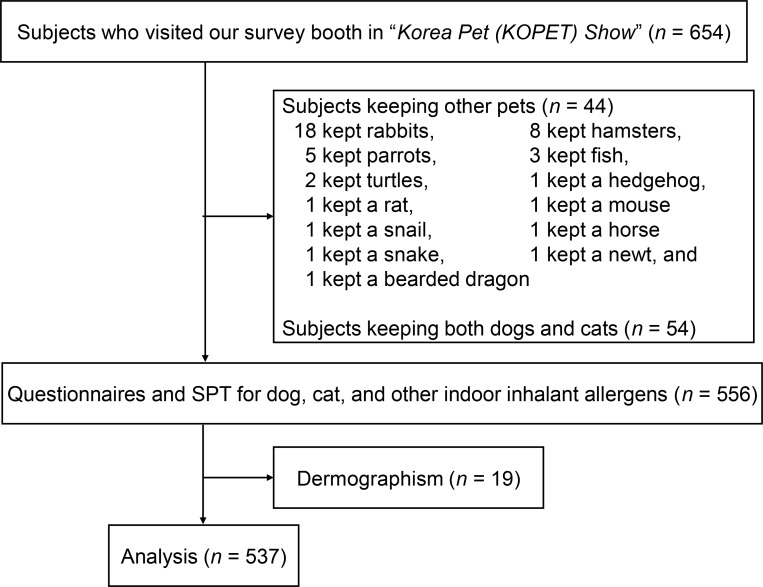
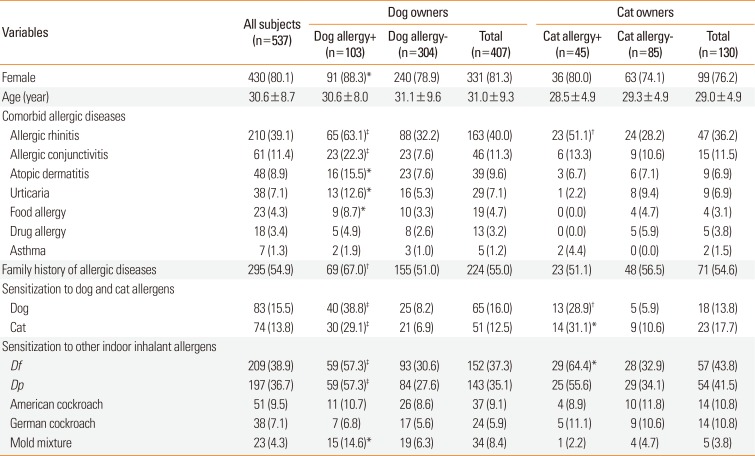
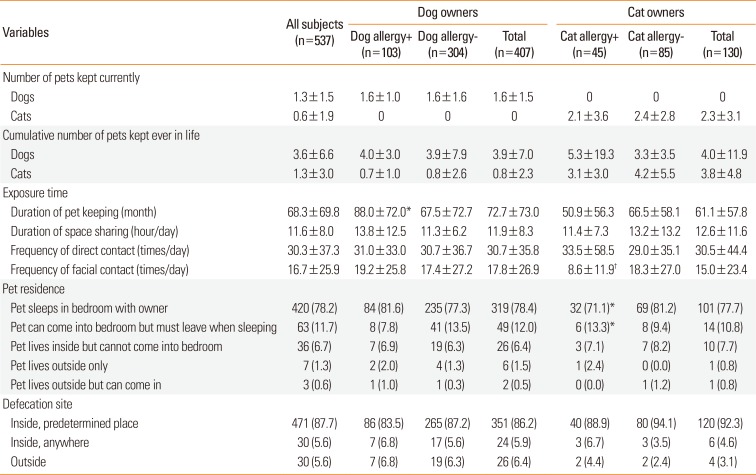

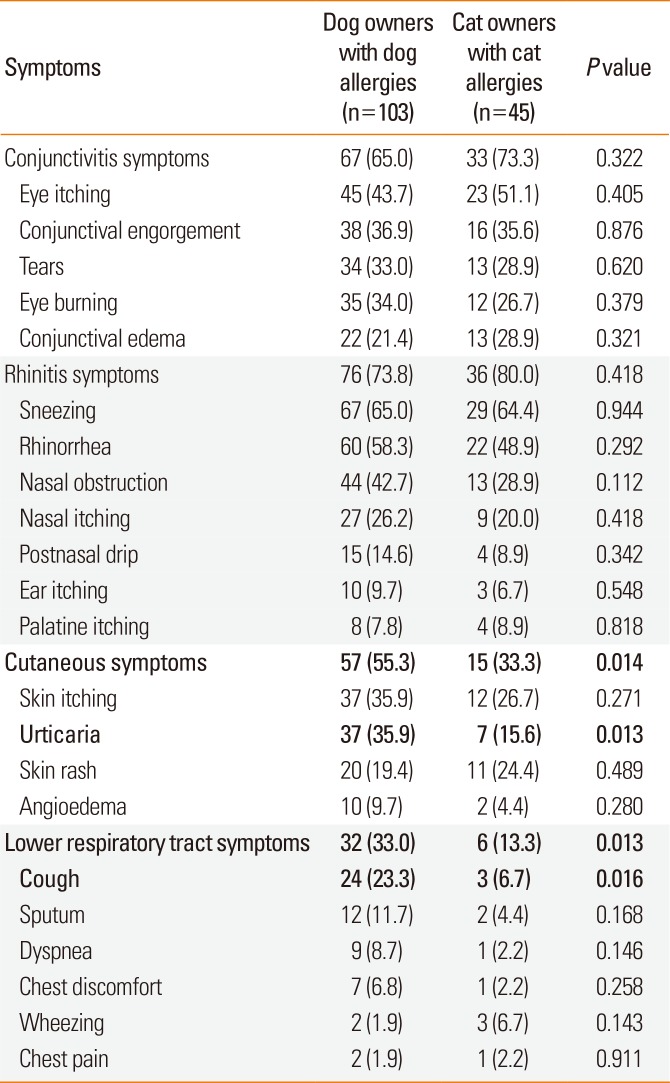




 PDF
PDF ePub
ePub Citation
Citation Print
Print


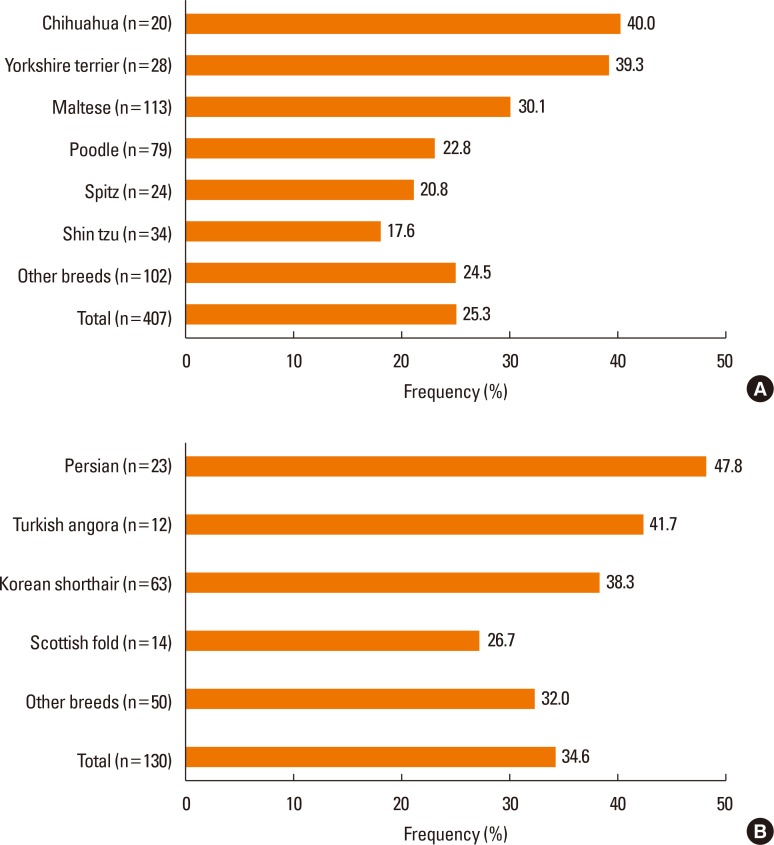
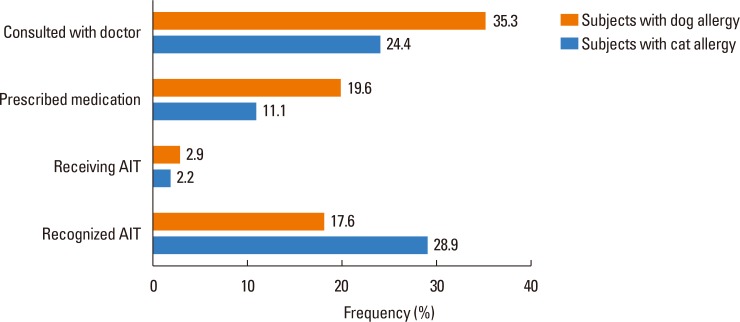
 XML Download
XML Download